Gwenifer Raymond on American primitive fingerstyle, spooky tunings and the morbid potential of the acoustic guitar
The Welsh-born guitarist draws upon classical punk, grunge and folk-horror to write dark, immersive acoustic compositions

Gwenifer Raymond’s rich, powerful solo acoustic instrumental music first took flight with her debut album, You Never Were Much Of A Dancer. A 13-song flurry of acoustic guitar and banjo compositions – very much in the vein of the big hitters of American primitive, John Fahey and Jack Rose – the set was a riveting demonstration of her often-blistering playing.
For Gwenifer’s second release, Strange Lights Over Garth Mountain, she has composed music that feels more personal and confident. Longer pieces unfold in complex forms and worry less about typical structure.
“The first album was the result of spending years playing in [American primitive] style and gathering songs,” she says. “Some of the riffs went back to when I was learning. With the second album, I’d been playing this music for a long time and at lots of shows, so by that point my voice had begun to come out more naturally. Before, I felt like I was trying to do this American primitive music, but with this one I was like, ‘I’m all right with whatever comes out.’”
Solo acoustic music is solitary by nature, but the pandemic put paid to Gwenifer’s plans to record the second album in a studio, forcing her to take a homemade approach.
“I had the whole thing ready to record in the studio right as lockdown happened,” she says. “So, instead, I dropped a couple of bucks on some mics – it was money I would’ve spent on studio time – and I recorded it in my bedroom. I intended to take my time over it, but I ended up doing a song or two an evening, in between waiting for the upstairs neighbour’s washing machine [to finish]. I recorded it all over a week and mixed it the following week.”
Sophisticated simplicity
Although Gwenifer doesn’t read music (“I’m a very impatient person…”) and tends to remember her tunes instead of writing them down, Strange Lights… remains complex and finely nuanced, with more sophistication than her debut.
“This one feels more compositional to me,” she says. “It’s a bit like classical music in that it’s got these ideas of movements instead of a verse-chorus-verse-chorus structure. It has a section that has a certain vibe, which evolves into something else and then returns to it again.
Get The Pick Newsletter
All the latest guitar news, interviews, lessons, reviews, deals and more, direct to your inbox!
"I’ve heard that more in classical and avant-garde stuff rather than folk music. It makes sense because I was listening to a lot of Erik Satie and Moondog, and all that kind of jam, when I was writing some of the songs.
“I also think a lot of the style-change came from a live-scoring gig that I did for silent movies, where I was assigned The Red Spectre, a French film from around 1907. So I wrote a track for it, which then turned into a single called The Three Deaths Of Red Spectre. And because it was for a movie it has a narrative to it where the mood changes, and I really liked that so I started doing that more. I still like a good riff, though.
“I started out in punk and grunge bands when I was a teenager,” Gwenifer says of her rockier roots. “I then got into blues music by way of influences I’d discovered, the most famous one being Nirvana doing Lead Belly on Unplugged. But there was Dylan and The Velvet Underground, too, and I discovered that pre-war blues was an influence on those players, so I started getting these cheap blues CDs.
"They were about a fiver in HMV, so I bought loads of them and got into guys like Mississippi John Hurt, Skip James and Blind Boy Fuller. I loved how they could make the guitar sound as if there was more than one playing.
“So I started teaching myself that [style of playing] and ended up finding a blues teacher in Cardiff who was a really good alternating thumb player. He taught me open tunings as well and, because I’m the worst singer in the world, I started composing these more complex pieces without vocals.”
Past influences
Gwenifer’s teacher went on to play her a record by John Fahey, which led to another turning point in her career, when she realised there were people making this music and that it was being heard. There is no denying Fahey’s genius and his trailblazing approach to solo acoustic guitar music, and the genre is now bursting with new, emerging players, as well as stalwarts such as Glenn Jones in the US and our own crop of talent here in the UK, which includes Gwenifer, Nick Jonah Davis, C Joynes and Toby Hay.
Gwenifer explains how she gets her sound
When Gwenifer began lessons in alternating thumb fingerstyle with her specialist tutor, she also started to explore the riches of alternate tunings, with a few becoming integral to her sound.
“My default tuning these days is probably C minor,” she tells us. “C G C G C Eb. It’s always the minor ones that I like, so I also go to G minor [D G D G Bb D] and D minor [DADFAD]. Very occasionally I’ll use a major tuning if I feel like it, but most of the time I’m in minor.
“They’re spooky. They just have that sound, that sympathetic drone that comes with them and gives them a spooky vibe that I like. That with a bit of discord – can’t beat it. I’m a big folk horror fan, too, I watch way too many horror films!”
“I think it’s cool that people are so interested in it now, because the more people you have doing stuff, the more likely it is that something interesting will come out of it,” Gwenifer says. “I’m not really into that whole pastoral guitar thing, though. I don’t like ‘pretty’ guitar, but that has also been a thing in American primitive music, that whole ‘sounds like a lovely green meadow with some cows in it’ thing.
“There are some players coming through now, though, that are getting into this weird angular, quite uncomfortable sound. People going goth, basically, which I’m always onboard with. What I don’t like is self-indulgent guitar and I think that comes from my punk roots. It annoys me when it’s all ‘look what I can do’ and the person that loves it the most is the person themselves. To me, most of the time, paring things down to their essentials is what turns it into a piece of art.”
Gwenifer’s picking style can be almost aggressively frenetic at times, her fingers blurring as she whips through her instrumental narratives. We talk about a Michael Chapman support slot at a venue in Bristol a few years back, where her finger-picks kept flying from her hand:
“That was a rough gig – it was the hottest place on Earth!” she laughs.
“I do like a bit of noise,” she continues, “but to me it’s also that ‘loud-quiet-loud’ thing, which is the easiest way to assert a mood change. On record it’s different, but playing live it’s almost like theatrics – and it’s exciting. I can’t help it, I just get taken away with it and it can be hard to rein it in sometimes. There might also be some pent-up aggression there, though, which is probably why I played in punk bands when I was a kid.”
Go-to guitars
When it comes to favoured acoustic guitars, one instrument sits at the top of the pile for Gwenifer: “My go-to is my Waterloo WL-14L. I recorded the whole album on this and it’s my live guitar as well. I got it because I was travelling around and touring and playing vintage guitars and just being terrified they were going to be smashed into a thousand pieces. Someone recommended Waterloo to me for that vintage sound that they have, without actually being vintage.”
Waterloo was a concept of the late Bill Collings, who envisaged a guitar with all the charm of an old Kalamazoo but built at the Collings factory in Texas to the same high standard as Collings guitars, albeit with a simpler spec and a lower price.
“It has such a solid build,” Gwenifer says. “My old Houn’ Dog [a Bradley Kincaid parlour model, built by Silvertone in the 1930s], which I recorded the first album on, its neck is so fucked that it’s unplayable above the 5th fret. I knew it was time for a modern guitar and I had a Gibson for a while, which was okay, but didn’t quite fill the hole, so then I managed to find this Waterloo for a great price and it’s spot on. I was really lucky because I bought it blind, having only heard it and not played it.”
Another gem in Gwenifer’s collection is a guitar gifted to her at 2018’s The Thousand Incarnations Of The Rose Festival in Takoma Park, Maryland.
“[Guitarist and composer] Henry Kaiser got in contact with Tompkins Square [Gwenifer’s record label] and said he had a guitar he wanted to give to me. I’d never spoken to him before, so I was quite surprised, but of course I said, ‘All right, I will accept a guitar.’ So when I got to the festival, it was there waiting for me. It’s amazing sounding,” says Gwenifer of the beautifully diminutive 1890 Joseph Bohmann parlour model.
“I was gigging it for a while, but I’ve stopped now because I’m scared of it. It’s got this crazy sick bass sound to it. I recorded The Three Deaths Of Red Spectre on that guitar. It’s got this big wide arse and a slightly rounded back, too, which makes it sound amazing.
“So yeah,” she laughs. “Henry Kaiser is a pretty stand-up guy!”
- Strange Lights Over Garth Mountain is out via Tompkins Square.
Glenn Kimpton is a freelance writer based in the west of England. His interest in English folk music came through players like Chris Wood and Martin Carthy, who also steered him towards alternate guitar tunings. From there, the solo acoustic instrumental genre, sometimes called American Primitive, became more important, with guitarists like Jack Rose, Glenn Jones and Robbie Basho eventually giving way to more contemporary players like William Tyler and Nick Jonah Davis. Most recently, Glenn has focused on a more improvised and experimental side to solo acoustic playing, both through his writing and his own music, with players like Bill Orcutt and Tashi Dorji being particularly significant.
“Among the most sought-after of all rhythm guitars… a power and projection unsurpassed by any other archtop”: Stromberg has made a long-awaited comeback, and we got our hands on its new Master 400 – a holy grail archtop with a price to match
The heaviest acoustic guitar ever made? Two budding builders craft an acoustic entirely from concrete because they “thought the idea was really funny”



![[from left] George Harrison with his Gretsch Country Gentleman, Norman Harris of Norman's Rare Guitars holds a gold-top Les Paul, John Fogerty with his legendary 1969 Rickenbacker](https://cdn.mos.cms.futurecdn.net/TuH3nuhn9etqjdn5sy4ntW.jpg)







